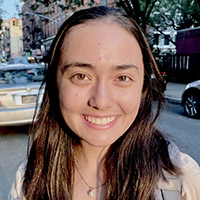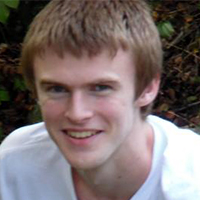From carbon capture to renewable energy technologies, 18 undergraduates funded for summer research
By Andlinger Center for Energy and the Environment Communications
The Andlinger Center for Energy and the Environment has awarded 18 undergraduates research funds to support research on energy- and environment-related projects. The research is supported by the Peter B. Lewis Fund for Student Innovation in Energy and the Environment, the Dede T. Bartlett P03 Fund for Student Research in Energy and the Environment, and the Sustainability Fund. The students’ projects are described below:
Internships with Princeton faculty
 Jaehee Ashley (CBE ’25)
Jaehee Ashley (CBE ’25)
Advised by José Avalos
Microbial Engineering for Energy and the Environment
The student will conduct research in synthetic biology, metabolic engineering, microbiology and/or fermentation technology to develop yeast and/or bacterial strains for the production of advanced biofuels and valuable chemicals from renewable sources. Argonautes are nucleases that cleave DNA or RNA using either DNA or RNA guide molecules without restrictions imposed by sequence motifs (i.e. PAM-sites). Genome editing guided by DNA instead of RNA, free from PAM-site restrictions, would be a game-changing technology, which would dramatically simplify genome editing procedures in currently hard-to-modify organisms like in crops used for bioenergy and microorganisms; these are hard to manipulate with CRISPR/Cas, such as microalgae and cyanobacteria, which are a great source for carbon recapture to sustainably produce biofuels and biohydrogen. In-vitro genome editing has been demonstrated in a handful of Argonautes; however, so far, no in-vivo genome editing has been reported. The student will finish out this characterization in vitro and in vivo. In doing so, hopes to find a candidate with the potential for genome editing in-vivo, increasing the potential of future genome editing for bioenergy production.
 Pranav Avva (COS ’24)
Pranav Avva (COS ’24)
Advised by Minjie Chen
Machine Learning Platform for Power Magnetics Modeling
The student will develop machine learning platform and database for data-driven power magnetics modeling. Power magnetics are key components in power electronics systems. They determine the volume, size, and efficiency of power electronics and play important roles in renewable energy systems and transportation electrification. The student will help develop neural network models to capture the behaviors of magnetic components across different temperatures, dc-bias, frequency, and amplitude range, and will explore novel ways of predicting the B-H loop of power magnetics under different excitations.
 Janelle Arnold (CBE ’23)
Janelle Arnold (CBE ’23)
Advised by Jonathan Conway
Engineering Plant Biomass Degradation in Extremely Thermophilic Bacteria
Caldicellulosiruptor species are the most thermophilic lignocellulose-degrading bacteria identified to date, with optimal growth temperatures between 70-78°C. Over the past 15 years, significant effort has gone into understanding the cellulolytic lifestyle and metabolism of Caldicellulosiruptor species with an eye toward using engineered strains for the production of biofuels and biochemicals from lignocellulosic feedstocks. This student will aid in advancing genetic tools in Caldicellulosiruptor species to enable more rapid genetic manipulation of this emerging metabolic engineering host. These genetic tools will be used to manipulate biomass degradation enzymes and processes for more effective degradation of lignocellulosic biomass substrates.
 Helena Frudit (MAE ’25)
Helena Frudit (MAE ’25)
Advised by Chris Greig and Richard Moss
Exploring Resilient Net-zero Energy Pathways Using Structured Risk Assessment
Aspirations to transition the United States’ economy to net-zero emissions by 2050 are subject to a variety of execution risks and impacts of a changing climate. The student will assess and compare the vulnerability of different net-zero pathways to various execution transition and climate impact risks, using a structured risk assessment framework consistent with ISO:31000. The objective of the work is to identify net-zero pathways, which are more resilient. Possible transition risks include the inability to deploy zero-carbon infrastructure at the required pace and scale due to: constraints related to capital mobilization, supply chains, siting, and permitting; community opposition due to perceived or potential impacts on consumption patterns, income/wealth, landscapes, and other aspects of their way of life; and resistance from incumbent firms and labor groups due to threats to current business models and employment opportunities (e.g., fossil fuels). Future energy systems and infrastructure may also be vulnerable to risks associated with future changes in climate including extreme weather events (storms, flooding, droughts, etc.), increased warming, and sea-level rise, leading to reduced reliability or performance.
 Frida Ruiz (MAE ’25)
Frida Ruiz (MAE ’25)
Advised by Kelsey Hatzell
Chemo-Mechanics in Solid-State Batteries
Li metal all solid-state batteries present the opportunity to increase the energy density of lithium-ion batteries by 2X, making them applicable to long-range electric vehicles. Despite their promise, it is unclear how operating strategies of solid-state batteries will differ from conventional batteries and how cells can be manufactured. This research project and the student will examine the role of pressure in influencing battery performance.
Joshua Yi (PHY ’25)
Advised by Yiguang Ju
Studies of Ferroelectric Plasma Catalysts on Chemical Synthesis
The student will help to develop and test new ferroelectric plasma catalysts to synthesize ammonia more efficiently with lower carbon emissions in a non-equilibrium plasma reactor. The project involves catalyst design, flame synthesis, and plasma aided non-equilibrium ammonia synthesis using ferroelectric plasma catalysts. The goal of the internship is to synthesize ammonia more efficiently and with fewer pollutants than the conventional Haber-Bosch method. This is important as ammonia is an extremely important chemical for agriculture, plastics, and explosives. Unfortunately, the current process is very energy-intensive and requires high pressures (450-600 bar) to carry out the reaction. By contrast, plasma generation can happen at lower temperatures and pressures, reducing the cost to the environment. To do this, nitrogen and hydrogen gas are converted to a plasma, and then a catalyst is added. The purpose of this internship is to discover, design, and test different catalysts for use in synthesizing ammonia.
 Lilianna Gittoes (ORF ’24)
Lilianna Gittoes (ORF ’24)
Advised by Eric Larson
Design of CO2 Capture/Storage Hubs
The Energy Systems Analysis Group (ESAG) is exploring the prospective spatial and temporal evolution of CO2 capture and storage (CCS) “hubs” in the United States. Hubs include existing and planned CO2-emitting facilities in the petrochemical, power, and industrial sectors, as well as future facilities converting biomass feedstocks into hydrogen, electricity or other clean energy carriers. A deeper understanding of potential performance, benefits, costs, and challenges associated with such hubs will help inform policy and investment decision-making that can accelerate the deployment of CCS. This will be essential in the effort to fully decarbonize the economy. The Louisiana Gulf Coast regions have been selected for a case study for which methodological and modeling tools are being developed to help understand prospective technology and infrastructure costs and performance. Working on a daily basis with postdoctoral fellows, the student will assist with the analysis and visualization of results.
 Sreeta Basu (MAT ’24)
Sreeta Basu (MAT ’24)
Advised by Eric Larson
Real Option Analysis for Decarbonizing New Jersey Transit (NJT) Rail Operations
The Energy Systems Analysis Group (ESAG) is developing a framework to assess and evaluate options to invest in technologies that will underpin NJT’s path to a carbon-neutral electricity supply. The framework is based on the theory of real option analysis (ROA). This ‘option approach’ is based on American financial call options: an investor has the choice to invest today or to postpone investing. The choice of whether to invest or to hold the option is driven by the assessed value of the option and the net present value of the investment. NJT, as an investor, has managerial flexibility to choose the timing of their investments in new technologies. If the value of a technology option exceeds the expected returns to be gained in exercising the option, investments will be postponed, and vice versa. By understanding investment options in different technologies and associated investment decisions, a framework can be developed for evaluating policies aimed at accelerating investments and evaluating how much should be invested, for example in research and development, to keep alternative options alive. The student will assist in modeling technologies and technology combinations in the assessment framework. The results of the assessment will be translated into tables and graphs. The student may also contribute to the analysis of different investment options and in the formulation of technology-specific conclusions.
 Freddie Furia (COS ’24)
Freddie Furia (COS ’24)
Advised by Sonya Legg and Henri Drake
The Climate Impacts of Ocean Thermal Energy Conversion (OTEC)
Ocean Thermal Energy Conversion (OTEC) is a proven renewable energy technology with the potential capability of providing the base-load power required to complement intermittent solar and wind power. OTEC functions like a typical heat engine, with the innovation being that the heating of the working fluid – typically pressurized ammonia – is provided by warm tropical ocean surface waters, while cold waters from below the deep ocean act as the coolant. At scale, OTEC plants are imagined to be floating barges with near-surface intakes of warm water and cold water intake pipes extending down into the abyss. Their only byproduct is the lukewarm discharge of seawater, a mixture of the two input water masses. Since OTEC is fueled by these naturally-occurring thermal ocean gradients, a logical question is whether sufficiently large OTEC deployments, acting as a non-local analog of natural ocean mixing processes, could deplete this resource or otherwise result in their own climate change impacts. The goal of this project is to develop a software module (“parameterization”) for OTEC in the GFDL climate model and to investigate the impacts of realistic OTEC production levels on ocean climate, as well as potential feedbacks back into the OTEC system.
 John Kim (ELE ’25)
John Kim (ELE ’25)
Advised by Barry Rand
Conductivity of Organic Thin-Film Crystals
Organic semiconducting (OSC) materials are desirable for their electrical and optical tunability, flexibility, and low-cost fabrication in thin-film devices. Already these materials have found commercial success in the form of organic light-emitting diodes (OLEDs) but other applications, such as organic solar cells, require more research. Currently, most organic devices are currently made with highly disordered, amorphous films despite known OSCs with the ability to crystallize. Generally, crystallized materials have higher conductance than their amorphous counterparts, increasing the carrier mobility and efficiency of the device. Our research group has identified five OSCs that can crystallize into large area domains with the potential to be used in thin-film devices. The student will be working to fabricate these OSCs into crystalline and amorphous thin films and compare their conductivity in an effort to determine the ideal materials and conditions for fabricating organic thin-film devices.
 Darius Rudasingwa Ganza (CBE ’24)
Darius Rudasingwa Ganza (CBE ’24)
Advised by Michele Sarazen
Metal-organic Frameworks for CO2 Capture and Conversion
Strategies for capture of anthropogenic CO2 are needed to meet net-zero (or net-negative) emission goals. Solid sorbents are attractive CO2 capture alternatives to liquid amines utilized historically, as downstream regeneration procedures are less energy-intensive. Metal-organic frameworks (MOF) are one class of porous materials that have promising attributes for capture and conversion processes. They are formed by nodes of metal ions or metal oxide clusters linked by organic ligands, resulting in a diverse and large set of pore networks. This project that the student will support will combine material synthesis and kinetic experiments of MOFs as adsorbents for CO2 capture and catalysts for its subsequent conversion to valuable chemical building blocks.
 Stephen Jiang (ORF ’25)
Stephen Jiang (ORF ’25)
Advised by Ronnie Sircar
Quantifying Uncertainty in Electricity Generation
The projected significant increase in the use of renewables such as wind and solar for electricity production will inject massive uncertainty into the grid due to their intermittency. Hitherto, this stochasticity has largely been absorbed by assuming the accuracy of production forecasts, resulting in the operation of a deterministic system. This internship is part of a larger effort of the Operations Research and Financial Engineering department to bring risk mitigation and quantification tools of statistics, probability, and optimization to stabilize future electric grids.
 Zhaoran Chen (ARC ’24)
Zhaoran Chen (ARC ’24)
Advised by Elke Weber
Coalition Building for Net-Zero Futures: Case studies in Appalachia
This project will explore how networks of stakeholders come together to form coalitions that aim to drive a net-zero energy transition. This research seeks to understand what stakeholders lead and push coalitions forward, and what tensions and tradeoffs influence buy-in from diverse groups of stakeholders (including private companies, local political groups, labor organizations, religious groups, NGOs, etc.). Specific research questions include: 1) What types of narratives do these coalitions form around a clean energy transition in relation to economic revitalization, labor organization, and notions of procedural and distributional justice? 2) How are these narratives perceived by the communities that will be directly impacted by job loss and land-use change? and 3) How do community members and other stakeholders envision a “just transition?” Case studies will be conducted across the Appalachian region in the eastern United States, focusing on communities in Pennsylvania, Ohio, West Virginia, and Kentucky. Known for its economic dependence on coal and political hesitancy to embrace a renewable energy transition, Appalachia faces extreme economic shifts and land-use changes. These shifts, in the form of job loss and community change, will continue to profoundly impact resident livelihoods. This project will engage with communities on the ground, collecting qualitative data through interviews with key stakeholders and focus groups with community members to better understand the makeup and
 Merry Hertan (CEE ’24)
Merry Hertan (CEE ’24)
Advised by Claire White
The Materials Science of Sustainable Cements
Professor White’s research group is focused on developing new sustainable concrete by understanding and optimizing the sub-micron processes (i.e., reactions) occurring in conventional and alternative cements. This undergraduate research project will complement one of the ongoing projects being undertaken in the group and will include working in a wet lab with graduate students to synthesize materials together. The student will use and learn various experimental characterization equipment, such as X-ray diffraction, Fourier transform infrared spectroscopy and thermogravimetric analysis.
 Ben Bobell (PHY ’23)
Ben Bobell (PHY ’23)
Advised by Emily Carter
Dynamics of Carbonate Formation
Through a mineralization process of carbon dioxide (CO2) into carbonates, such as CaCO3 and MgCO3, atmospheric CO2 can be removed from the atmosphere and stored. This mineralization process consists of reactions where either there is hydration of CO2 into carbonic acid (H2CO3) or local excess OH- aids the formation of bicarbonate (HCO3 – ) and carbonate (CO3 – ). The research goal is to use a multi-level simulation process of both static and dynamic models, in which the research team builds up the scale of our simulation, to understand the molecular dynamics of CO2 and its mineralization process in seawater at the atomic level. Doing so will allow us to design materials that can accelerate a natural mineralization process that otherwise occurs at long geologic time scales. To describe the distribution of the electrons within the molecules, we use density functional theory (DFT) and correlated wavefunction (CW) methods. The Carter Group has found that a dynamical simulation is required to better understand the energy of this system. This project will involve the use of deep neural networks to learn and develop atomic potentials from DFT simulations for aqueous CO2 and to eventually include Ca2+ , Mg2+ , Clions to understand CO2 mineralization in seawater.
Internships with outside organizations
 Riti Bhandarkar (CEE ’23)
Riti Bhandarkar (CEE ’23)
EDF Energy Transition Analytics Intern
EDF+Business forges unexpected partnerships that catalyze environmental leadership and collaboration across companies and supply chains. We combine cutting-edge science, economic expertise, and unexpected partnerships to help high-impact companies – including BP, Legal & General Investment Management, Lyft and Sephora – transform business as usual. Sitting within EDF+Business and reporting to the senior manager of the investor influence team, the energy transition analytics intern will play a central role in conducting research and analysis on the energy sector and emerging energy transition topics to inform communications aimed at investors and financial institutions. The intern will assist in developing thought leadership for EDF’s new investor insights platform. The platform equips the financial community with the independent analysis and tools needed to manage climate risk, assess opportunities, and accelerate urgent action in the sectors that matter most.
 Kaixing Chou (SPI ’23)
Kaixing Chou (SPI ’23)
Vehicles Electrification Intern
To facilitate a transition within the transportation sector, EDF is working on solutions for deployment of medium and heavy-duty trucks and buses by working with major fleet operators, manufacturers, electric utilities, and other key stakeholders to establish new business, finance, and regulatory models. These solutions will reduce local air and climate pollution by bringing down the cost of vehicle ownership, facilitating the deployment of critical charging infrastructure, and encouraging the use of managed charging to encourage the expansion and use of clean energy. As part of that, participation in state and federal venues to shape regulatory and policy outcomes, and socialization of relevant research, is critical. The vehicles electrification intern will primarily work on policy advocacy at state energy and environmental agencies in California concerning the transition to zero emissions medium and heavy-duty trucks and buses. Within this role, the main topics covered will be regulation and oversight of electric vehicle charging and deployment programs, and practices that are relevant to ensuring transport electrification occurs in a cost-effective, equitable, and environmentally beneficial manner. The intern will contribute to these efforts by working closely with in-house attorneys and policy experts to advance winning positions through coalition building, comment and testimony preparation and delivery, and formal representation of EDF in regulatory proceedings where EDF is a participant.
 Samir Bhojwani (ECO ’25)
Samir Bhojwani (ECO ’25)
Energy Markets Regulation Intern
The Federal Energy Regulatory Commission (FERC), located in Washington, D.C., regulates interstate sales of electricity and transmission of electricity. FERC also promotes strong national energy infrastructure, including adequate transmission facilities. FERC’s Office of Energy Market Regulation, Division of Electric Power Regulation analyzes regulatory filings involving Regional Transmission Organization (RTO)/Independent System Operator (ISO) wholesale electricity markets and other electric rate matters related to wholesale energy sales and transmission of electric energy in interstate commerce. The intern will learn about the fundamentals of wholesale electricity markets from FERC experts, participate in interdisciplinary teams analyzing regulatory filings, and work with a mentor to define an independent research project at the intersection of engineering, economics, and policy. At the conclusion of the internship, the intern will present their research findings to the Office of Energy Market Regulation’s senior leadership. Past research topics have included: participation rules for new energy technologies, including renewables, demand response, and storage resources in electricity markets; transmission expansion required to achieve decarbonization goals; and electricity market reforms necessary to integrate distributed energy resources.
Read about past internship projects and experiences below:
2021, 2020, 2019, 2018, and 2017 recipients
From bird watching to code writing, Riti Bhandarkar reflects on her path to energy
Andlinger summer program yields summer exploration and new pathways
People spotlight: Audrey Shih – studying polymer flow for groundwater remediation